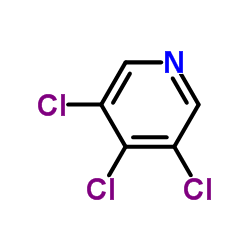3,4,5-Trichloropyridine

3,4,5-Trichloropyridine structure
|
Common Name | 3,4,5-Trichloropyridine | ||
|---|---|---|---|---|
| CAS Number | 33216-52-3 | Molecular Weight | 182.43 | |
| Density | 1.5±0.1 g/cm3 | Boiling Point | 209.6±35.0 °C at 760 mmHg | |
| Molecular Formula | C5H2Cl3N | Melting Point | 75-77°C | |
| MSDS | Chinese USA | Flash Point | 100.2±11.5 °C | |
| Symbol |

GHS07 |
Signal Word | Warning | |
|
A general analytical platform and strategy in search for illegal drugs.
J. Pharm. Biomed. Anal. 100 , 215-29, (2014) An effective screening procedure to identify and quantify active pharmaceutical substances in suspected illegal medicinal products is described. The analytical platform, consisting of accurate mass determination with liquid chromatography time-of-flight mass ... |
|
|
Application of quantitative NMR for purity determination of standard ACE inhibitors.
J. Pharm. Biomed. Anal. 114 , 190-9, (2015) This study investigated the accuracy of the quantitative NMR method for purity determination of ACE inhibitors reference standards and the discovery of two pairs of new diastereoisomers. Six types of ACE inhibitors, imidapril hydrochloride, benazepril hydroch... |
|
|
Use and qualification of primary and secondary standards employed in quantitative ¹H NMR spectroscopy of pharmaceuticals.
J. Pharm. Biomed. Anal. , doi:10.1016/j.jpba.2013.09.010, (2013) Standards are required in quantitative NMR (qNMR) to obtain accurate and precise results. In this study acetanilide was established and used as a primary standard. Six other chemicals were selected as secondary standards: 3,4,5-trichloropyridine, dimethyltere... |
|
|
Survey and qualification of internal standards for quantification by 1H NMR spectroscopy.
J. Pharm. Biomed. Anal. 52(5) , 645-51, (2010) In quantitative NMR (qNMR) selection of an appropriate internal standard proves to be crucial. In this study, 25 candidate compounds considered to be potent internal standards were investigated with respect to the ability of providing unique signal chemical s... |
|
|
A practical, efficient, and rapid method for the oxidation of electron deficient pyridines using trifluoroacetic anhydride and hydrogen peroxide-urea complex. Caron S, et al.
Tetrahedron Lett. 41(14) , 2299-2302, (2000)
|